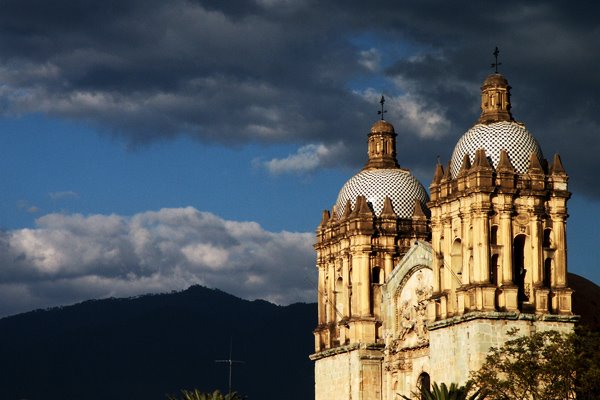The wind is howling across the mountains and valleys. The air dry and cool. What a change.
The drive back from the coast takes one through so many different changes of scenery and climate, like going from one world to another. There are not many roads that cut through the mountains and Henry Wangeman and I tried a different one yesterday, one that cut across from Rio Grande, close to the coast, through Juquila, Lachoa, Sola de Vega and eventually back to the city. At times we were on a single lane dirt road high in the mountains, but it did cut maybe an hour or two off the drive and the scenery was fantastic.
One leaves the hot, humid and fertile coastal plains, filled with papayas and palms and heads up into the sere mountains, then into cool, moist, alpine air, where the land is filled with tall pines, then down through valleys filled with banana and mango trees, up again, down again, s-curve after s-curve. As we came over the last ridge we could see Oaxaca in the distance and miracle of miracles, it was raining, What a welcome home.
There are so many aspects to this trip that it will take a few days to process. For some, the pounding and dangerous waves and deserted beach near Corralero, a meal of fresh oysters, shrimp and fish might be a highlight, but for me it was the villages, each with its own energy and flavor. At times, I felt I was transported back in time as I watch dances that had hundreds of years, maybe thousands, behind them. The hypnotic sounds of the sonajas or rattles, the solo violin and guitar that accompanied many of the dances are still in my head. Such a primal sound, one that is hard to let go. Henry has a theory that it is by doing these dances every year that the world keeps going. The more I think about it, the more I agree. It was all pretty other-worldly.
In almost every village we were the only gringos, almost the only outsiders. That being said, it was crazy to see how well Henry is known in these villages after all his years of working with artesanos. We walked into a huge crowd watching the dances in Pinotepa Don Luis and within literally 15 seconds, the announcer on the PA spotted him and acknowledged his presence. "We are so happy that Hnery Wangeman is here from Oaxaca." It happened in San Juan Colorado, too.
These are not tourist attractions. They are the traditions of these villages with long links into the distant past. I hasten to add, I wish more tourists, both Mexican and international, could see these celebrations. There is something very deep and moving in them.
Lots of things to observe, about which to learn. Like the striped purple pozahuancos worn by the women, not only in the villages, but also in Pinotepa Nacional, a large city. These are beautiful fabrics made using a back strap loom and normally worn with no top, maybe a white hand-woven rebozo to go out. This is the tropics. It is hot and humid. However, in the 1950's, the INI or Instituto Nacional Indigenista decided that the women needed to cover up and told them to wear aprons to cover their breasts. So one sees these gorgeous wrap around skirts covered up with just the most absurd aprons. How to preserve indigenous culture.... and that was the charge of the council. Still, some woman still stick to the old ways.
Or villages having a "real" queen and then an indigenous queen. Things that make you go hmmmmm.
The here and now... and what and why
Complacency is a trap. At least that’s what I was thinking when I up and left the comfort of a Yankee prep school gig, where I taught music, amongst other things, for 28 years. There was also that life long career as a composer, musician and artist.
First, it was a year in St. Thomas, USVI, working as a reporter and shooting photography and then, a year in San Agustin Etla, Oaxaca, Mexico.
Time passed.
More time passed and a year back in the Athens of America followed by a hasty return to Oaxaca where it is all happening.
A couple of years in San Sebastian Etla and now, just down the road in San Pablo Etla. Life is good.
Click on an image to see it larger.
For additional photography please visit my flickr page.
You can find my music on Jango (World & latin - Worldbeat) and at iTunes and most online stores.
¡Soy consciente de todas las tradiciones del Internet!
If you are coming to Oaxaca, please contact me for tours or advice.
First, it was a year in St. Thomas, USVI, working as a reporter and shooting photography and then, a year in San Agustin Etla, Oaxaca, Mexico.
Time passed.
More time passed and a year back in the Athens of America followed by a hasty return to Oaxaca where it is all happening.
A couple of years in San Sebastian Etla and now, just down the road in San Pablo Etla. Life is good.
Click on an image to see it larger.
For additional photography please visit my flickr page.
You can find my music on Jango (World & latin - Worldbeat) and at iTunes and most online stores.
¡Soy consciente de todas las tradiciones del Internet!
If you are coming to Oaxaca, please contact me for tours or advice.
Santo Domingo

The view from Corazon del Pueblo
The hereafter re me

- Christopher Stowens
- Oaxaca, Oaxaca, Mexico
- Musician, photographer, videographer, reporter, ex-officio teacher, now attempting to be a world traveler
No comments:
Post a Comment